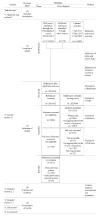The Cognitive-Emotional Design and Study of Architectural Space: A Scoping Review of Neuroarchitecture and Its Precursor Approaches
- PMID: 33801037
- PMCID: PMC8004070
- DOI: 10.3390/s21062193
The Cognitive-Emotional Design and Study of Architectural Space: A Scoping Review of Neuroarchitecture and Its Precursor Approaches
Abstract
Humans respond cognitively and emotionally to the built environment. The modern possibility of recording the neural activity of subjects during exposure to environmental situations, using neuroscientific techniques and virtual reality, provides a promising framework for future design and studies of the built environment. The discipline derived is termed "neuroarchitecture". Given neuroarchitecture's transdisciplinary nature, it progresses needs to be reviewed in a contextualised way, together with its precursor approaches. The present article presents a scoping review, which maps out the broad areas on which the new discipline is based. The limitations, controversies, benefits, impact on the professional sectors involved, and potential of neuroarchitecture and its precursors' approaches are critically addressed.
Keywords: architecture; built environment; emotional design; neuroarchitecture; neuroscience; review.
Conflict of interest statement
The authors declare no conflict of interest. The funders had no role in the design of the study, in the collection, analyses, or interpretation of data, in the writing of the manuscript, or in the decision to publish the results.
Figures




References
-
- Williams Goldhagen S. Welcome to Your World: How the Built Environment Shapes our Lives. HarperCollins; New York, NY, USA: 2017.
-
- Ledoux J.E. Cognitive-Emotional Interactions in the Brain. Cogn. Emot. 2008;3:267–289. doi: 10.1080/02699938908412709. - DOI
-
- Glass D.C., Singer J.E. Urban Stress: Experiments on Noise and Social stressors. Academic Press; New York, NY, USA: 1972.
-
- Ulrich R.S. Visual landscapes and psychological well-being. Landsc. Res. 1979;4:17–23. doi: 10.1080/01426397908705892. - DOI
Publication types
MeSH terms
Grants and funding
LinkOut - more resources
Full Text Sources
Other Literature Sources

